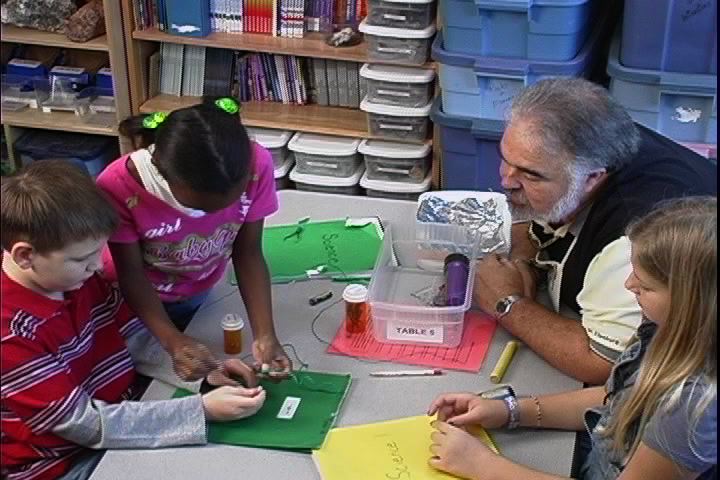
Many have asked for more information about our school garden. This is a reprint of an article I wrote for KidsGardening.
As many look to the fall season as a time of winding down classroom gardening, there are places where you will find a second gardening season filled with flowers, butterflies and vegetables. Gardening in Florida provides just such an opportunity. As you travel south until fall leaves cease to exist you will find a region of year round gardening that many would envy. As a science lab teacher and native Floridian my students and I do not experience the beauty of fall leaves or excitement of the first snow, but our garden is filled with the color of flowers in December, our garden still hosts caterpillars and butterflies in January and we harvest cucumbers and tomatoes almost year round. Raised beds provide the year round home for dill, mint, pentas, salvia, milkweed, fennel and much more.
For years my elementary school garden has enjoyed the advantages and challenges unique to year round gardening. In the sub tropic zone of Central and South Florida the cool mornings of fall aren’t usually felt until mid November; a winter freeze threat usually exists for only a few weeks in January and February; our spring planting begins in early March; and summer comes to us in May. With the opportunity of an extended growing season come challenges. Garden pests are a year round concern; the depletion of soil nutrients is an ongoing battle; and garden management and maintenance become critical gardening skills.
Because the challenge of year round gardening can be overwhelming, in our school garden we have approached everything in manageable stages. Our research and past experiences helped us to realize that the soil in Florida is mostly composed of sand and organic matter and our rain pattern is seasonally inconsistent. As a result we undertook creating a diverse raised bed garden supported by in-ground sites where appropriate. The decision to rely on raised beds was made due to a number of factors. 1. We could more easily enrich the soil and control moisture, 2. We provide better control of nematodes and other garden pests, 3. All students would have equal access to the garden – from kindergartners to fifth graders to our physically challenged students, 4. We could better control weeds. Most of our beds are large, measuring eight feet square, others much smaller. Container gardens also are found throughout our garden and allow us to provide a greater diversity of plants.
Large beds were developed to provide the following experiences: one bed is filled with assorted mints, lavender, and other scented plants for a sensory experience; one bed contains only annuals so that students may better understand plant life cycles; two beds provide host plants for both caterpillars and butterflies (we have focused on Monarchs, Queens, Viceroys, assorted Swallowtails, Gulf Fritillary and Sulfurs); a bed of perennials is provided to measure plant growth; a bed of ginger and cannas allows us to explore bulbs; a bed dedicated to Southern wildflowers allows students to better understand that one region’s weed in another region’s wildflower ; a bed of vegetables that are constantly harvested; and assorted container groupings of kalanchoe, sunflowers, roses, ornamental trees and other plants.
Soil is revitalized courtesy of our rabbitry which provides the foundation for our large composter. Additional soil is obtained from composted matter available at our county landfill. Irrigation as needed is supplied through web-like hose of connected sprinklers we have created linking each bed to our main water supply. Our goal was to use as little water as possible. Seeds from the garden are collected, dried and added back to the beds as part of our understanding of the life cycle. The garden is maintained by our afterschool gardening club, as well as volunteer classes. Pruning and weeding are ongoing and vital to our gardens. With a mild year round climate many plants will grow at accelerated rates. Without a period of dormancy many plants have been planted in small areas only to eventually take over the entire garden space. Our own experience started one year with a Mexican Petunia staging a revolt and attempting to take over our entire garden through a network of vine-like roots. Unable to learn our lesson, we repeated the cycle with a determined ornamental potato vine.
Water gardening is popular in our state, but has its own challenges. Evaporation leads the list. If fish are part of the water gardening experience then tap water must be ruled out as the water source. Many gardeners have rain barrels or filtration systems designed to provide a constant source of appropriate water. Too much or too little water depletes necessary nutrients creating more work, and our wonderful sun also contributes to high growth of algae! And don’t forget that you may also find the occasional egret or crane looking for his next meal in your water garden!
Regardless of how you approach gardening in Florida the joys far exceed any challenges one might encounter. Our school garden has become such an integral part of our community that last spring it was the site of evening Garden Party attended by over 400 students and their families. Though we might out on miss the colors of fall leaves and the clean fields associated with the first snow, we in the Sunshine State celebrate with an explosion of colors everyday and invite you to come down and share in the warmth and excitement of year round gardening!
























